Desert Goby - Chlamydogobius
eremius (Zietz, 1896)
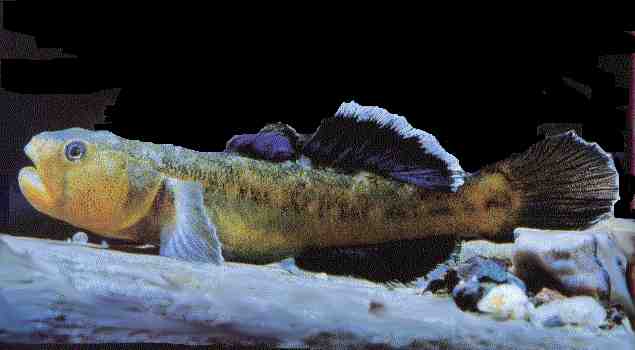
Male Desert Goby |
Description: Small goby
with fused ventrals
and large dorsal fin; body colour is yellowish with black speckling and
a hint of blue in dominant males; unpaired fins are black and edged in
blue-white, except for the first dorsal which is yellow edged and has a
large metallic blue dot in the centre.
Distribution: Endemic to
central Australia.
Natural Habitat: demersal;
freshwater; pH
range: 7.0 - 8.0; dH range: 9.0 - 19.0; occurs in pools, permanent
waterholes
and streams associated with artesian springs and bores and subject to
high
evaporation and thus the water conditions vary considerably with rain
and
evaporation levels across the habitat.
Climate: temperate; 10 - 35°C,
with
low night temperatures in winter; high ground temperatures in
summer.
Conservation Status: Not in
IUCN
Red List.
Threats: Unknown
Size: 6.0 cm TL.; females smaller
than
males.
|
Water Requirements: Freshwater that
is
moderately hard, pH 7.0- 8.0; dH 9.0 - 19.0, and contains some salt but
not brackish. Ideal temperature range is 20-22°C.
Adaptable,
easy to keep and breed; short lived at higher temperature range.
Tank Habitat: Fine gravel substrate
with
rocky
hiding places; some floating cover such as Duckweed.
Diet: Feeds on insects, crustaceans,
filamentous
algae and detritus. Will take flake foods and frozen or dried
live
foods.
Sexing: Males have blue/black
second
dorsal fin, edged in white, which is larger than in female; males have
larger mouth than females; females lack colouring of male and show a
prominent
black spot on the first dorsal fin.
Reproduction: Egg layers on
substrate
(hidden); guarders; male guards eggs in a clutch. Males will mate
with a number of females in his brooding hollow (in crevices and under
rocks). Fry may be eaten in close quarters.
Tank Community: Species tank
only:
keep
in trios or with more females than males.
Incompatible Species:
larger fish; wading birds.
[Information Source:
Index
of Freshwater Fishes sv. Chlamydogobius eremius.]
Comments: Acquired: One pair,
10/19/2001. Initially set up in a small tank with cut flower pot hide.
Purple Spotted
Gudgeons
There are two very similar species, the
Northern
Purple Spotted Gudgeon and the Southern Purple Spotted Gudgeon.
The
former is still common in its range, while the latter species is
endangered,
having become extinct over most of its southern range, especially in South
Australia and Victoria.
Southern Purple Spotted Gudgeon - Mogurnda adspersa
(Castelnua, 1878) Chequered Gudgeon,
Trout
Gudgeon.
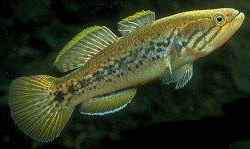
Mogurnda adspersa, is an
endangered
species.
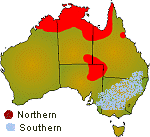
Map shows former range of the two
species of Purple
Spotted Gudgeons.
|
Description: Small
elongate, large mouthed
gudgeon, with golden brown body colour and purple-magenta
spotting
laterally and on the tail; two prominant eye stripes diagonally
backwards
from the eye and a parallel third strip on the operculum. Has two
dorsal fins, of which the second is the larger and edged in
yellow/green
or white; anal fin edged in blue-white; short ventral fins resemble
those
of a goby but are not conjoined.
This fish rarely swims
continuously. Longer
distances accomplished by a series of jerky darts.
Distribution: endemic
to Australia, in the Murray- Darling System of Victoria, New
South
Wales and Queensland; perhaps South Australia; originally its
distribution
extended into Northern Victoria where it had been presumed extinct
since
the 1930's. Recently re-discovered in the Cardross Lakes (an
irrigation
drainage basin system) near Mildura in Northern Victoria; also found in
eastern coastal drainages north of the Clarence River, New South
Wales. Introduced widely in dams.
Natural Habitat: benthopelagic,
freshwater;
Climate: subtropical; 16 - 20°C; 14°S - 36°S. Inhabits
slow-flowing
or still waters, among weed.
Conservation Status: Rare across its
range;
Endangered in Victoria. A protected species in the Queensland, Burnett
River Catchment area; listed for conservation in other areas. Breeding
programs are active in S.A and Victoria.
Threats: Competition with
introduced
species; habitat destruction; rising salinity in the River Murray-Darling
System; pollution from agricultural run-off..
Size: 14.0 cm TL (male/unsexed); At
maturity,
female at 4.9 cm, male at 4.5 cm.
Water Requirements: freshwater; pH
range:
7.0; dH range: 10.0 - 20.0; temperature range 15- 24°C.
Tank Habitat:
Still, hard, freshwater; pH range: 7.0- 7.4; planted and with
rocky hiding places.
|
Diet: Feeds on worms, dragonfly
larvae,
midge and mosquito larvae, crustaceans and small fishes. An
ambush
predator, lying motionless on bottom until suitable prey approaches.
Eats
feral Mosquitofish (Gambusia spp.); will eventually take pellet foods; does best
on live foods.
Sexing: Sexually dimorphic: males
may
have a slightly more pronounced "bump" on the head and the
male urinogenital papilla is pointed whereas that of the female
is
shorter.
Reproduction: external dioecism;
guarders
and tenders, with pair spawning in rivers and ponds at 19-34°C in
Dec.-Feb,
during one, clear, seasonal peak per year. A single cluster of demersal
eggs laid on a solid substrate, often close to vegetation. Male swims
around
female with all fins erect and opercula expanded. This courting
behavior
may continue for some days. Male cleans spawning site and pairs with a
gravid female. Eggs deposited in clusters on solid objects such
as
rocks, wood, broad leafed plants. Female deposits about 30 eggs and
then
rests while male fertilizes them. She then continues to lay another
batch.
After producing about 280-1300 eggs, the female moves away and the male
remains to fan and guard the eggs until hatching, which takes about 7 -
9 days. Remove parent once fry are hatched.
Tank Community: This
species is not recommended for private fish keeping but is bred in
conservation
programs in species only tanks. The following species is recommended for
aquarists.
Northern Purple Spotted Gudgeon - Mogurnda
mogurnda (Castelnua, 1878)
Australian
Chequered Gudgeon, Trout Gudgeon.
| Description: Small
elongate, trout-like
gudgeon, with greenish body colour and purple-magenta spotting
laterally
and on the tail, pinkish colouring on the operculum; five prominant
"facial"stripes diagonally backwards from the eye and a cross the operculum.
Has two dorsal fins, of which the second is
the larger and edged in yellow/green or white; anal fin edged in
blue-white; short ventral fins resemble those of a goby but are not
conjoined. |
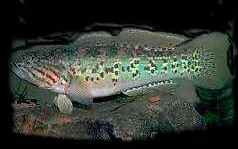 Male
M.
mogurnda
Male
M.
mogurnda |

Distribution |
Distribution: Widely
distributed across Northern Australia and southern New Guinea.
Australian
range extends from Cape York, adjacent to the Gulf of Carpentria, to
the
gulf drainages, Arnhem Land in the Northern Territory, Western
Australia
as far west as Fitzroy River. Also found in the Lake Eyre
drainage,
N.T., Qld., S.A..
[Source:
Native
Fish Asociation Ref: Northern P S Gudgeon]
Map shows former Australian range
of the Northern
Purple Spotted Gudgeon in red. Note
the northern SA population.
|
Natural Habitat: benthopelagic,
freshwater creeks, billabongs and streams; found in dams and bores;
found
in murky waters as well as clear waters, with wide physiochemical
tolerances.
M. mogurnda can withstand short periods of low oxygen levels, water
temperatures from 5°C to at least 32°C and salinities up to 10,000
parts
per million.
Conservation Status: Not in
IUCN
Red List.
Threats: Regarded as
non-threatened.
Size: up
to 170 mm; most commonly about 100 mm TL.
Water Requirements: Best
in cool to warm, moderately hard feshwater, temperature 20 - 27°C
(will
tolerate slow drop in temperature to 5°C. Tolerates a wide
range
of water parameters.
Tank Habitat:
Large tank, gravel bottom (u/g filtration adequate if acidification is
monitored) with very little water movement. Provide planted
areas,
retreats and cover.
Diet: Mainly
carnivorous, feeds on a variety of insects and crustaceans, molluscs,
other
fish, worms and some plant material. Takes live foods, frozen
foods
and flakes in captivity.
Sexing:
some slight sexual dimorphism- males more vividly coloured and with a
pronounced
"bump" on the head; sexing is generally difficult except in breeding
season.
See below:-
Reproduction: Sexual
dimorphism is displayed during the breeding season, the male
urinogenital
papilla are pointed and may attain an intense blue colouration,
in
females the papilla are short and broad with a fringed margin.
Spawning
involves the adults swimming closely together, the female deposits a
patch
of demersal, adhesive eggs on a hard surface such a rock or log.
Each clutch is around 50 mm in diameter and contains around 100 to 150
eggs. During the breeding season (November to February) the
female
may deposit up to 10 clutches. The male remains on guard over the
eggs, fanning them with his pectoral fins to maintain a current of
water
until they hatch in about 9 days. Will breed in captivity. It has
been suggested that it is best if one female is kept with several males
but I have had breeding success with pairs. Often the
female
deposits the eggs on the glass of the aquarium. The female and
other
males should be removed after spawning and the brooding male
after
the eggs hatch. If the adults are not removed, they will eat the
larvae and any remaining eggs. Larvae can be raised on newly
hatched
brine shrimp, micro-worms and small rotifers, until they take finely
powdered
dry foods. Growth is rapid. Source:
Native
Fish Asociation Ref: Northern Purple Spotted Gudgeon]
Tank Community: Does well with
Rainbowfish.
This fish has amazing jumping abilities- so house in a covered tank or
large pond, with weed cover. A very
attractive
and popular aquarium species, reasonable easily obtained though the
aquarium
trade. Often mistaken for the endangered Southern Purple Spotted
Gudgeon to which it is very similar. Best maintained in a tank
with
adequate cover and with a water temperature between 20 to
27°C.
The fish tends to be a fairly belligerent bottom dweller and will
usually
take only live or fresh foods. Suitable foods include small
earthworms,
brine shrimp and daphnia. Beef-heart mix can be given as
well.
Comments: Suitable for
mosquito
control in dams.
Incompatible Species:
Larger fishes.
Comments: I
caught this species in billabongs along the Adelaide River, NT, during
1970-71 and kept them in the school's aquaria with Rainbows. This species makes
a delightful subject and does well with Rainbowfish in a large tank. Acquired: 1
pair, Jan. 2001. Breeding began 26 October, 2001.
To breed this pair, I placed them in a small, covered
28 litre
tank (a plastic storage box, actually), with water depth about 30 cms
and
the tank bare except for floating Java Fern and half a coconut
shell.
Filtration was via a mature sponge filter. The fish were fed on
live
foods and frozen beef heart and left undisturbed except for feeding and
partial water changes each week. The female was courted by the
male
in a more vigourous chase than described above, but not violent.
The first batch of spawn was laid inside the coconut shell. Free
swimming fry were seen 6 days after spawning. Subsequent spawning
sites were on the walls and bottom of the tank. They
produced
several broods during the summer months, from October 2001 to March
2002.
For the first two weeks, the fry are very small and were fed
on infusoria,
"green water" rich in rotifers and single-celled algae, and microworms
then on newly hatched brine shrimp. They were gradually
introduced
to powdered dry foods over the next few weeks. There was a marked
difference in growth rate among individuals in the batch, with some
fish
taking brine shrimp and very fine beef-heart mix at one month of age
and
others still requiring very fine foods.
Firetailed Gudgeon
-
Hypseleotris
galii (Ogilby 1898)
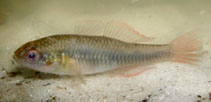 |
Description: Class:
Actinopterygii (ray-finned
fishes). Order: Perciformes; Family: Eleotridae (Sleepers); Small,
olive/bronze
gudgeon with grey lateral stripe and reddish tail; has a compressed body,
two dorsal fins and a small, oblique mouth that reaches to below the
front of the eye. Not an active
species but can move fast when disturbed. The colouration of his species
varies with age, habitat and season. The body is generally grey to
bronze with black scale margins. During the breeding season males
can be almost black, with intense red-orange fins. There is often a
black bar above the pectoral fins base and a faint stripe along the
side of the body.
Distribution: Australia:
coastal drainages
of eastern Australia from Fraser Island, in Queensland to Eden in
southern
New South Wales. Introduced to dams; now widespread in Australia.
|
Natural Habitat: demersal; warm
temperate
freshwater. Occurs in streams, ponds, swamps, usually among aquatic
weeds;
also found in dams, irrigation canals and drains.
Conservation Status: Not in
IUCN
Red List.
Threats: habitat degradation.
Size: to 5.5 cm TL; 4.0 cm TL
(female);
Water Requirements: freshwater, pH
6.5
- 8; temperate; 10°C - 30°C; lives longer at lower temperature
range 15°C - 24°C; adequate filtration provided by u / g
systems
or sponge filters with low water flow; water changes essential to keep
nitrate levels low.
Tank Habitat: Freshwater, with rocky
cover
and plants, best kept in pairs in small aquaria; adapts well to a quiet
aquarium, and can be kept with small Rainbowfish.
Diet: Omnivorous; an ambush feeder,
feeding
mainly on insects and small crustaceans.
Sexing:
Easier once pairs form with female with eggs having a fatter abdomen.
Female Firetailed Gudgeons can be easily distinguished from other
species of Hypseleotris by the black area around the vent. This
area is usually brown in males.
Reproduction: dioecism; guarders and
nesters;
Female lays adhesive eggs on the roof of a rocky ledge. Male guards and
fans the nest until hatching takes place after 3-5 days.
Tank Community: Shy, needs plant and
rock
cover.
Incompatible Species:
Introduced
trout and cichlids; larger fishes.
Comments: Important fish for
Mosquito
control within its natural range. I have kept them but they are not an active
species.
Toxotes
jaculatrix (Pallas 1767) syn. Toxotes jaculator,
Archerfish;
Rifle Fish.
Toxotes
chatareus
(Hamilton, 1822) Large Scaled Archerfish; Seven-spot Archerfish.
|
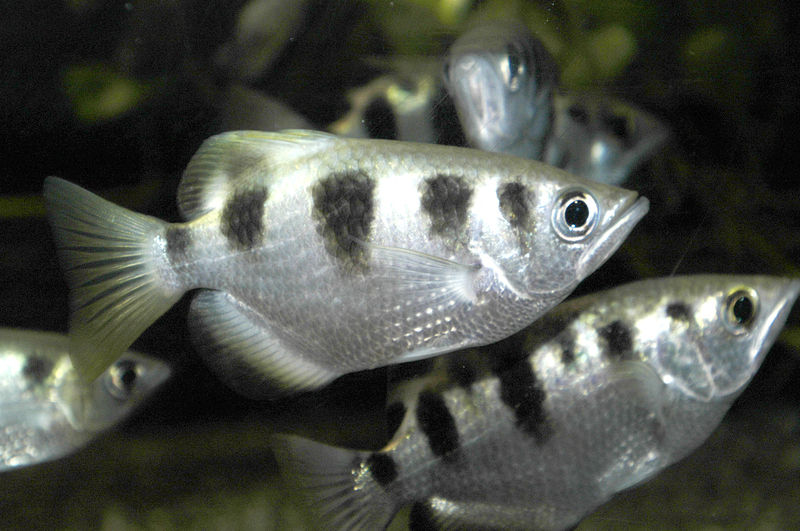
Toxotes jaculatrix
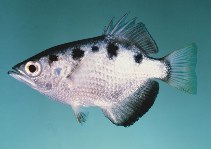
Toxotes charateus
|
Description: Laterally
compressed, deep
bodied fish with an arrow-head-like outline; body colour white, with
black
bars or spots above the lateral line. Very active. Diagnosis
of species:
Toxotes jaculatrix-
Dorsal
spines (total): 4-4; Dorsal softrays (total): 11-13; Anal spines: 3-3;
Anal soft-rays: 15-17.
C.f. Toxotes charateus-
Dorsal spines (total): 5-6; Dorsal softrays (total): 12-13; Anal
spines:
3-3; Anal soft-rays: 15-17. T. charateus grows larger, to 40.0 cm SL
(male/unsexed);
max.weight: 750.0 gms.
Distribution: Asia
and Oceania: from India eastward to the Philippines, and south to
Indonesia,
Vanuatu, Solomon Islands, Papua New Guinea, and northern Australia.
Australia:
Rivers and estuaries of northern Australia: Darwin, Alligator, Mary,
Katherine,
Daly, Roper and Adelaide Rivers; Gulf Of Carpentaria drainage area;
rivers
of North Eastern Australia.
I loved watching these active
fishes in the Daly
and Adelaide Rivers, N.T. They are always on the move, scanning
the
areas above and on the water, for insects.
Natural Habitat: pelagic;
freshwater; brackish
water; Climate: tropical; 25 - 30°C. An estuarine species,
migrates
into lower reaches of rivers and is also found in billabongs.
Lives
near the water surface, constantly on the move. Occurs primarily
in brackish mangrove estuaries, but also penetrates rivers and small
streams.
Reported to occur near overhanging vegetation on reefs. Feeds at the
surface
during daytime on floating debris which includes insects and vegetable
matter. It is renowned for its ability to 'shoot down' insect prey by
expelling
beads of water from its mouth with considerable force and for its
remarkable
ability to compensate for visual refraction when aiming its shoots;
shooting
range is about 150 cm. Will extinguish a glowing cigarette with one shot!
Conservation Status: Not in
IUCN
Red List.
Threats: Over fishing.
Size: A large fish to 30.0 cm TL
(male/unsexed).
Water Requirements:
Tropical freshwater to brackish water in estuaries; Brackish water
is
best for these fish.
Tank Habitat: Medium to
very large tank
with free swimming spaces is essential; surface area is more important
that depth but tank not too shallow; cover is essential. Some
floating
cover may help easily frightened individual fish. The water must
be well oxygenated and have very good biological filtration. Archerfish
also tolerate water movement.
|
Diet: Predatory on small
frogs,
fish, and crustaceans, as well as insects, which it shoots down with a
well directed jet of water. Jumps to retrieve prey.
Adapts to frozen foods and floating high protein pellets.
Sexing: no information.
Reproduction: no information.
Tank Community: A
very large tank with Rainbows and the less aggressive mbuna works well, although Archer fish do not do
well
with aggressive species in confined space. Scats and Monos may
work;
Archerfish are relatively shy, take fright easily and jump: they are
best
kept away from fin nipping species and smaller fish that may make a
nice
meal. T. chatareus requires considerably more room than
T.
jaculatrix.
Incompatible Species:
Aggressive
fishes; larger Archerfish; fin nippers; Arowanas.
Importance: fisheries:
minor commercial; aquarium: commercial. Sold fresh in
markets.
[Information Source:
Index
of Freshwater Fishes sv.
Toxotes
jaculatrix.]
Comments: Both Toxotes jaculatrix
and T. chatareus can be kept with large Rainbows as a "dither
fish";
they does best in brackish water environment. |
|
Scatophagus
argus (Linnaeus 1766) Spotted Scat, Red Scat
|
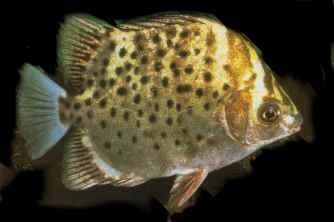
Scatophagus argus argus,
Spotted
Scat. |
Description: A shoaling species.
Laterally
compressed, deep bodied fish with a small head; body colour barred
golden
to brassy yellow, white ventrally, with darker bars and black spots
over
the body; vertical eye stripe and some facial stripes. Small
mouth.
Several varieties exist, such as the Spotted and Red Scats.
Diagnosis of species: C.f. Scatophagus tetracanthus (Lacepède,
1802) - Dorsal
spines (total): 11-11; Dorsal softrays (total): 15-18; Anal spines:
4-4;
Anal soft-rays: 14-15
Distribution: Indo-West
Pacific; off shore reefs and estuaries and rivers: Australian
distribution
in estuaries and lagoons of the Indo-Pacific coast.
Natural Habitat: benthopelagic;
freshwater;
brackish; marine environments. Climate: tropical; 22 - 30°C. Found
in harbours, lagoons and estuaries, venturing into freshwater during
periods
of flooding and high rainfall.
Conservation Status: Not in
IUCN
Red List.
Threats: no information.
Size: 30.0 cm TL (male/unsexed)
|
Water Requirements: Brackish, tropical
water is best for these fish. Juveniles can be
adapted
to freshwater to which a little salt has been added.
Tank Habitat: Medium to large tank
with free swimming spaces; plants not essential; good filtration;
partial
water changes weekly.
Diet: Feeds
on detritus and benthic invertebrates; accepts black worms, brine
shrimp,
flakes; eats plants in aquaria.
Sexing: no information.
Reproduction: no information.
Tank Community: A
very large tank with Monos works well, under brackish conditions.
A peaceful fish, that adapts well to aquaria when young. Keep in
small shoals.
Incompatible Species: Seems
to hold its own with a wide range of brackish water species.
Importance: aquarium:
commercial. Sold fresh in markets.
[Information Source:
Index
of Freshwater Fishes sv.
Scatophagus
tetracanthus;
plus personal field experience.]
Comments: I have
found that this species will eat aquatic plants and algae with a
determination
that makes any take plant free tucker; adapts well to being kept with small
Archerfish. A form that I caught from the Daly River
estuary
has a bright red vertical mark running down the front of the head
between
the eyes. I kept several of these in a freshwater aquarium,
together
with Rainbowfish, Archerfish and Sailfin Mollies. Colour was brighter yellow in
juvenile fish. |
|

A Habitat for Rainbows, Scats and Archerfish |
HOME
My Rainbowfish Page
Notes on
Fish Keeping
Bettas
Treating Diseases in Bettas
and Other Fishes
IUCN Red List.
Disclaimer
|
|


 Male
M.
mogurnda
Male
M.
mogurnda


